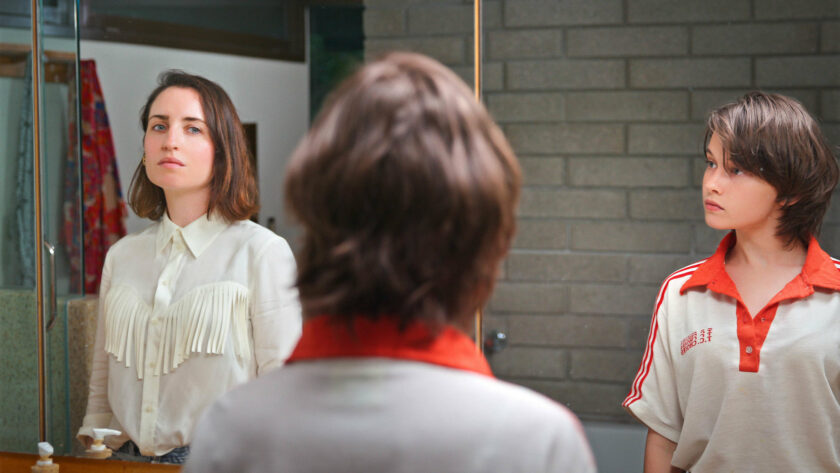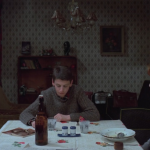Alexander Hancock reviews an end-of-the-world feature shot entirely during the COVID-19 pandemic.
As a colossal asteroid makes its fateful trek to planet earth, 30-something year old Liza (Zoe Lister-Jones) concocts an extensive to-do list before the world comes crashing down. The checklist involves making amends with her distant father, airing her grievances with an old friend, scolding an ex-boyfriend and rekindling her romance with a past lover. And maybe finding the confidence to speak with her estranged mother, though she’s a little unsure about that one. Once she’s ticked all of this off her list, she’ll spend her last hours on Earth at an “end-of-the-world party” as a last hurrah.
Accompanying Liza on her farewell tour is her “metaphysical” younger self (Cailee Spaeny); a precocious child with chopped hair and an (assumed) affinity for bowling shirts. Skipping around L.A, the two couldn’t be more different. Current Liza is cynical, while her younger self is an optimist. Liza is jaded, while her younger self is brimming with zeal. And while adult Liza feels somewhat indifferent about the impending asteroid, her child self still grasps on to a glimmer of hope that the whole “end of the world” spiel is some outlandish hoax. Nevertheless, the two set out across the City of Angels, determined to right their past wrongs and to tie up all of the loose ends they’ve left during their lifetime. Their journey becomes somewhat of a road trip – sans car, after they discover it was stolen – around the various neighbourhoods of Los Angeles, meeting a few eccentric characters along the way. As they reunite with friends and family from their past and present, Liza and her younger self are forced to confront their mistakes and regrets whilst their precious time on Earth begins to dwindle.
How It Ends was written and directed by Daryl Wein and Zoe Lister-Jones and was shot during the pandemic. While the 2-metre distance between characters is an indication of the strange times within which the film was created, the bleak and pessimistic tone you might expect to come out of a quarantine-based film isn’t really there. Instead, Wein and Lister-Jones’ take on the pre-apocalyptic genre is a rather joyous affair. The sunny streets of L.A lined with billowing palm trees paired with the comedic performances of the two leads provide a much-needed reprieve from the onslaught of sombre dramas we’ve come to anticipate during the past year. That’s not to say that this film doesn’t feature some heavy moments; Liza’s realisation that she’s wasted the past couple of years resenting her parents when she could have been spending time with them is an emotional standout, though the film’s spirit doesn’t exactly reflect the direness of its title.
However, unlike the two leads of the film, How It Ends often doesn’t know where it’s going. As the characters meander through the maze that is Los Angeles, so too does the film’s tone. While its exploration of lingering guilt and the challenges of growing up is both powerful and moving, its depictions of L.A’s wealthy feels like a not-so subtle — and unnecessary — dig at the city’s breezy and crystal energy-loving population. Liza’s homebrewing dad (Bradley Whitford) boasts of setting sail and swimming with dolphins during his final hours, while her old friend (Olivia Wilde) reveals her abilities as a clairvoyant, foreseeing Liza’s afterlife with her soon-to-be partner, Timothée Chalamet. (The film features a seemingly neverending stream of cameos including Wilde and Nick Kroll, though Chalamet – sorry to disappoint – never shows up). These narrative pivots often detract from the more sentimental moments of the film, like when the protagonist confesses to feeling abandoned by her parents after their divorce. Right after Liza laments the lost time between her and parents, her father explains the healing properties of purging negative energy, forcing her to perform a physical ritual to relieve her of pent-up frustration. These short sketch-like vignettes elicit a chuckle here and there, but don’t offer much of a lasting impression. It’s a shame because the comedic chemistry between Liza and her younger self is more than enough to fill the entirety of the film.
At its core, How It Ends explores the inextricable ties that bind the past and present. It examines the difficulties of growing up and how, over time, the optimism and hopefulness we carry as children begins to wither away. The film cleverly subverts our expectations of what befriending our younger selves might look like. Rather than adult Liza acting as the voice of reason, her younger self is the rational one, while still maintaining a passion for life and a genuine belief in the kindness of others. It’s often child-Liza who is cleaning up the mess her adult self leaves behind, simultaneously offering sound advice and much-needed reassurance. Wein and Lister-Jones’ screenplay never tips the emotional scale to the point of becoming syrupy, but instead, paints an honest depiction of childhood innocence through the lens of Liza’s exuberant younger self. Watching the two characters sit together — two separate snapshots of the same person — is a reminder of the changes we undergo from free-spirited kids with little concern about the judgement of others, to weary adults riddled with doubts and insecurities.
Despite the odd road bump, How It Ends finds its footing in the quieter moments. Lister-Jones and Spaeny deliver dynamic performances as an unlikely duo, trekking across the barren streets of Los Angeles whilst mending all the broken parts of their past. The dialogue is both endearing and thought-provoking and provides a much-needed respite in the midst of these challenging times. Despite the heaviness of the film’s subject – it’s hard to imagine an uplifting ‘end of the world’ story – its message is ultimately hopeful: that in spite of the ebbs and flows we experience after our childhood years, our relationship with our younger self is never really lost.




